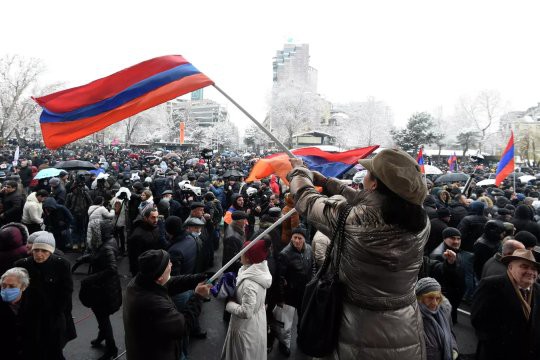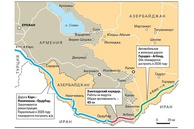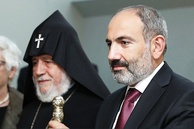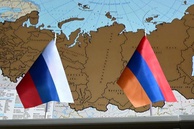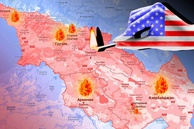To save Pashinyan
Mass protests, the most wide-ranging of all the years Nikol Pashinyan has been in power, demanding his resignation, have caused grave concerns I the West. The analytical center of the European Council on Foreign Relations (ECFR) published [1] on May 31 an article urging the European Union to send clear signals of support to the government of Pashinyan, or it will be brought down: «After two lost wars in 2020 and 2023 the Armenian society’s trust in Pasinyan dropped and the absence of clear signals of support from the West may ruin his ratings yet further». ECFR warned in the above mentioned article that protest movement in Armenia might intensify, bringing to power pro-Russian forces “which will destroy the fragile Armenian democracy».
Significantly, many representatives of the political spectrum in Turkey, concerned that protests in Armenia could thwart any attempts “to nail down” Pasinyan, have openly made statements in his support. Nevzat Cicek, Chief Editor of Independent Türkçe, one of the most popular ones, with the largest number of news media audience in Turkey, said in an interview: «Honestly, the Armenian leader (Pashinyan – author) should be protected by Turkish special task forces»[2], – he pointed out.
Western countries have undoubtedly supported the government of Pashinyan even if by not condemning (but rather, encouraging) the brutal crackdowns on the protesters, even though in other cases, for example, in Georgia, they were quick to react negatively without delay. In addition, high-ranking American officials have been keeping a close eye on the developments. Before the May 26 rally the republic was visited by Deputy Director of the Central Intelligence Agency David Cohen, before the rally near parliament on June 12 - Так, перед митингом 26 мая в республику приехал замдиректора ЦРУ Дэвид Коэн, перед акцией у парламента 12 июня — US Assistant Secretary of State James O’Brien paid a visit. The American officials must have been consulting the Armenian authorities on how to dispel the protests and must have authorized the use of force. Yerevan was also visited by a delegation of the US Congress[3]. Everything was done to save Nikol Pashinyan.
As a result, at the end of June, some gleefully, some bitterly acknowledged that the protest movement “Tavush for the Motherland” had subsided significantly. After record in scope rallies in May and early June, with dozens of thousands participants, the rally on June 17, organized by the leader of the movement, Archbishop Bagrat Galstanyan, was attended by considerably fewer protesters. The archbishop proclaimed the need to reformat[4] the movement and reconsider its strategy. Having removed the tent camp which had been put up in front of the Armenian National Assembly, the opposition has held no large-scale rallies ever since.
Even the church has proved powerless to consolidate the Armenian opposition. Unity was affected by a clash of ambitions with some openly claiming that “their waters cannot flow in one stream”[5].
Fairly soon, all concerns expressed by political scientists proved true: less than in a month, the activists found themselves torn by inner battles. The opposition-controlled media were publicly discrediting individual activists from the inconsistent opposition, the internet was flooded with records of compromising conversations……One of the recent protest leaders Suren Petrosyan put the blame for the crisis [6] on his former associates and the parliamentary opposition of Armenia, which consists mainly of the Republican Party headed by the third President S.Sargsyan and forces concentrated around the second President R.Kocharyan. «While they are in politics, people, faced with a choice between them and Pashinyan, will always opt for the latter”, S.Petrosyan says.
Authorities create virtual “real Armenia”
Paradoxically, the movement “Tavush for the Motherland” has strengthened the positions of the current authorities. The prime minister imposes his interpretation of the reasons for protests’ failure, saying that the public turned out to be closer to the idea of “real Armenia”[7], which consented to the surrender of Nagorno-Karabakh, and to further unilateral concessions. In the words of the head of the government, the ruling majority (the Civil Contract Party) is all but the expression of society will.
Critics argue, though, that the prime minister’s team, rather than expressing the will of the people, is making use of their will-lessness. While fully understanding the need to settle the complicated and multifaceted Karabakh conflict, we have to acknowledge that society apathy is the result of the six-year policy of the Pashinyan administration and consistent brainwashing.
After instilling their NPO-alumni in the Armenian leadership in the heat of the “velvet revolution”, western manipulators received an unlimited access to control of the media and to the government propaganda machine. Pashinhyan exerted tremendous efforts to assume control of the “fourth branch of power”: top posts in agencies regulating public television went to people close to the government, laws were amended to intensify control of the media.
Speaking at the 31st session of the OSCE Parliamentary Assembly in Bucharest, opposition deputy from the Aiastan faction Lilit Galstyan told the audience about [8] a campaign against freedom of expression in Armenia, about intolerance and violence against journalists and the unprecedented number of political prisoners.
The incumbent authorities have been trying to re-format public consciousness with the help of government-controlled social networks, whose role continues to grow. «Facebook», which has changed its name to be known as «Meta» (listed in Russia as an extremist organization), is covering nearly as much audience as television. Social networks narrow people’s circle to sect or community members, who communicate only with the like-minded, without facing arguments that could shake their beliefs. A mass influx of information or disinformation (fakes) via social networks produces a strong influence on public opinion in Armenia.[9] There are a whole number of so-called «info-factories», which belong to Soros structures. In the opinion of Ani Samsonyan, a member of the 7th National Assembly of Armenia (2019-2021), «the authorities have made use of this fake-producing factory to create a virtual state and to pass all decisions crucial for the country by promoting this factory»[10].
This very virtual state is known as «real Armenia», which contrasts with historical Armenia. The head of the government intends to draw «the demarcation line between real and historical Armenia», which «are not only incompatible, but create serious threats for each other»[11].
Surprisingly, it was in Turkey that Nikol Pashinyan found those like-minded. Turkey’s ex-Ambassador to Azerbaijan Hulusi Kilic has praised Armenia’s Prime Minister Nikol Pashinyan for his understanding of the fact that the idea of historical Armenian lands is «wrong» and for accepting the «reality»[12]. This is an important historical move, though at the current stage, it is not the most important one.
Acting from the inside, the authorities have been striking at the foundation stones underlying the traditional values, such as the army (by firing the commanders that studied in Russia), religion (by encouraging attacks by sect members on the Armenian Apostolic Church (AAC)), statehood, historical memory …
The leader of the ruling party first signaled the need to create a new model of patriotism[13], and then got down to deleting from public consciousness the “obsolete) historical narratives, saying that neither the country’s coat of arms, which depicts Mount Ararat, nor the country’s anthem “have anything to do” with Present-day Armenia. Nex on the agenda is amending the Constitution.
In summer last year, as he congratulated the nation on Constitution Day, the Armenian prime minister described the reading of the fundamental law as “useful for everyone”. In the year that has passed, Nikol Pashinyan has radically changed his attitude to the country’s main rulebook – now he calls for amending it in oder to make the country “more competitive”[14]. Similar statements on the need to change the Armenian Constitution so that it no longer has any, as they say, “disputable” points, have been made repeatedly by Baku and Ankara.[15]
These demands play into Pashinyan’s hand. By having to introduce changes to the Constitution, he will be able to legitimize all his other decisions that run counter to national interests and the Armenian fundamental law. With a view to attract a wider audience, Armenia’s incumbent Prime Minister may in the future propose a referendum on this package of amendments, including a constitutionally recognized path towards membership in the EU. The Armenian leadership will thus set the stage for staying in power as long as possible, pursuing a behind-the-scenes but ever coming-to-the-fore policy of disengaging from Russia.
Public opinion polls refute statements about “real Armenia”
However, the attempts to completely re-format the mentality of Armenians have so far failed. People express viewpoints that are at odds with those imposed by “real Armenia”. A conclusion to this effect can be made on the basis of three surveys[16], which were held between March and May by Gallup International Association (GIA), which is unlikely to be suspected of sympathizing with the Armenian opposition.
Only 12,8% of respondents would be prepared to vote at hypothetical elections for Civil Contract, a party which Pashinyan has been trying, de facto unsuccessfully, to present as expressing the will of the society.
Only 8% of respondents gave positive estimates of the prime minister’s performance, whereas 75% thought negatively. Never before did the prime minister receive a negative rating that bad.
More than one third respondents approved of the movement for resignation of the prime minister which is run by Archbishop Bagrat Galstanyan.
84.2% of respondents spoke in favor of enshrining the memory of genocide in the Constitution – this demonstrates that an overwhelming majority support Historical Armenia, not the present-day pseudo "real Armenia”.
Meanwhile, there is a need to point out that the western tactic of all-pervading propaganda on the basis of manipulations, designed on western templates, has achieved some results. All television channels continue to impose an opinion that responsibility for foreign policy failures of the current Armenian leaders should lie with Moscow. The outcomes of public opinion polls by GIA demonstrate that the percentage of respondents who consider Russia the number one ally has dropped by nearly threefold.
Certainly, GIA’s methodology should be treated with caution, as the survey was conducted on the phone and among people of different ages irrespective of gender or education. And yet, the information in the surveys speaks of the moods running in a particular section of society.
Given the situation, what may present interest is public opinion research[17] (published for the first time and having a tentative nature), held at the end of June by third-year distance-learning students of Sociology Faculty of the Armenian State Pedagogical University for the purpose of finding out what people think about the movement “Tavush for the Motherland” and related issues.
At the end of June, as protests began to subside, most people signaled a negative attitude towars “Tavush for the Motherland”.
Chart 1
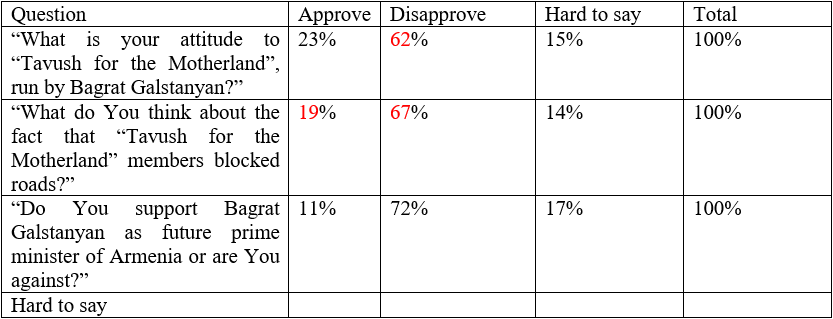
There are grounds to assume that this is the result of effective information campaign by government agencies and western NPOs, the fear of a new war, the unwillingness to see “former” elites back, and other factors of everyday concern. For one, the majority of the population feel negatively about blocking traffic as a method to exert pressure on the authorities, as it causes many problems and creates many inconveniences, in the first place, for ordinary residents[18]. The respondents also opposed the idea of the movement leader Archbishop Galstanyan becoming prime minister. This could be the result of both the above mentioned factors and the conscious or subconscious latent rejection of such an option by top opposition forces that claim power.
It is necessary to point out that according to the surveys, 60% of respondents will lose trust I the archbishop if they find out that he is being manipulated by former Armenian leaders. The information strategy to this effect has been used, intensively, and in all likelihood, effectively, by the current authorities, who have been spreading disinformation on a mass scale about B.Galstanyan’s ties with the second and third presidents of Armenia. All this was done for the sole purpose of ruining his reputation and the reputation of the Armenian Church headed by Catholicos of All Armenians Karekin II. Pashinyan, who justified the attacks against the Echmiadzin by alleging that he is suspected of hiding taxable income, even threatened to “settle the issue in the next two or three months”[19].
The survey probed into what the public thought about more involvement of the Armenian Apostolic Church in settling issues of national concern (as done by the Georgian Orthodox Church). As it turned out, only one third of the Armenian society approves of the Catholicos expressing his opinion on domestic policies, whereas half of the respondents are against. While this information could be put under doubt, what is surprising is that the surveys reveal a high percentage of those who would approve of violence against church clerics on the part of the police (45%) and would welcome economic pressure on the Church from the government.
Chart 3
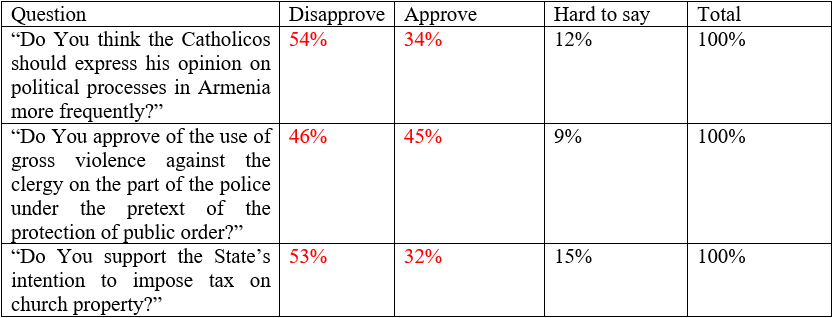
Such an attitude towards the AAC must be linked to the fact that, according to the Center for Rehabilitation of Victims of Destructive Cults, the republic has[20] 65 religious organizations (besides, there are 200 unregistered ones), of which about 54 are sects. About 350,000 Armenian residents of 687,000 voters, who voted for the ruling party in the June 2021 parliamentary elections, are members of different sects.
At present, the Armenian society is set on avoiding a new war which would be connected with delimitation of the border with Azerbaijan. However, two thirds of the respondents disagree that historical memory should be discarded in the name of peace.
Most believe that the delimitation is being carried out incorrectly, as it basically reduces Armenia’s defense capacity. However, the main point of the problem of delimitation is that the majority of society agree with the opinion that if it fails, a war will start. This, along with the opinion that it is necessary to avoid a new war at all costs, strengthens the position of the Armenian authorities in disputes with the opposition.
Thus, research outlines the following basic factors that characterize the attitude of the Armenian society towards the political confrontation between the government and the opposition:
- Maintaining peace and prosperity – the society does not want a war. A war is what the authorities and the opposition are using to frighten the people, as each of the conflicting parties argue that the activity of the other one will inevitably lead to war.
- While the society is cautious about AAC participation in political processes, the respondents express a great desire to see a political alternative.
- Major opposition parties have proved unable to offer a clear, positive and more valuable alternative. The movement has failed to produce new authoritative secular leaders whose names would not be linked to former leaders. There have appeared no seriously minded parties with clear ideology and program. The ambivalence and “multi-facedness” of the political agenda remain unchanged characteristics of opposition parties, due to which the society is unable to comprehend the essence and content of the programs of these parties.
Given this, the incumbent authorities have an edge over their opponents on all three factors.
***
The current authorities are pursuing a domestic policy that weakens historical memory and undermines the immunity of the civil society, de facto performing the order of their overseas curators, formulated in 2018 by National Security Advisor John Bolton: «the people of Armenia should not be fettered by historical templates».
Amid all this, the collective West is considering its relations with Armenia on three points: confrontation with Russia, formation of the South Caucasian flank for exerting pressure on Iran, and control of logistic routes, which will pass via South Caucasus: the “North-South” and “East-West” corridors.
The geopolitical orientation of the Armenian society and its historical memory will depend on the information flow, transmitted and operated by various information sources. We can agree to the opinion of Sergei Markedoov, senior researcher with the Institute of International Research of the Moscow State Institute of International Relations: «It is necessary to fight a battle for influence in Armenia, to fight not just for some uncertain geopolitics, but for the minds and souls of the Armenians. This is hard, but success is never the result of passive attitude. Fatalism is not a good option here. Roll up your sleeves and get down to work, rather than dwell on it, saying that “they will still be around, and if they are gone, it serves them right»[21].
The opinion of the author may not coincide with the position of the Editorial
[1] https://ecfr.eu/article/setting-boundaries-the-fallout-of-armenias-border-agreement-with-azerbaijan/
[2] https://politik.am/ru/nevzet-chichek-bezopasnost-nikola-pashinyana-dolzhny-obespechivat-bojtsy-turetskogo-spetsnaza
[3] https://vestikavkaza.ru/news/more-v-abhazii-progrelos-do-rekordnyh-znacenij.html
[4] https://eadaily.com/ru/news/2024/07/01/pashinyan-rasskazal-kogda-v-armenii-nikto-ne-smozhet-soprotivlyatsya-peremenam
[5] https://eadaily.com/ru/news/2024/07/03/dvizhenie-rabotaet-nad-oshibkami-lider-protesta-razocharovan-gagikom-carukyanom-smi
[6] https://eadaily.com/ru/news/2024/07/02/v-protestnom-dvizhenii-razoshlis-v-ocenkah-nazvana-oppoziciya-mechty-dlya-pashinyana
[7] https://ria.ru/20240623/pashinyan-1954883782.html?ysclid=lyc1vjmyma330984055
[8] https://hraparak.am/post/5a89c0e56bfee67c4dc3467915eafeac?ysclid=lycztgbg2b439686434
[9] https://am.sputniknews.ru/20201126/Travlya-karabakhtsev-i-roditeley-propavshikh-soldat-kak-rabotaet-armyanskaya-Fabrika-trolley-25504854.html
[11] https://www.primeminister.am/ru/statements-and-messages/item/2024/04/10/Nikol-Pashinyan-Speech/
[12] https://eadaily.com/ru/news/2024/05/30/byki-pohvalili-pashinyana-vedyot-armyanskiy-narod-pravilnoy-dorogoy
[13] https://newsarmenia.am/news/armenia/-pashinyan-zayavil-o-neobkhodimosti-sozdaniya-novoy-gosudarstvennoy-modeli-patriotizma/?ysclid=lydeohx7ap787057144
[14] https://www.primeminister.am/ru/statements-and-messages/item/2024/07/05/Nikol-Pashinyan-message-Constitution-Day/
[15] In the estimates of Azerbaijan, the number of individuals subject to “re-naturalizatio” in Armeni=a is 300,000. https://eadaily.com/ru/news/2024/07/03/okkupaciya-armenii-pod-gumanitarnym-prikrytiem-k-chemu-gotovy-pashinyan-i-ego-klevrety
[16] https://past.am/?p=357785&l=ru#gsc.tab=0
https://newsarmenia.am/news/politics/pochti-tret-respondentov-sotsoprosa-v-armenii-vyskazalis-za-otstavku-pashinyana/?ysclid=lyeri2ddan513792413;
https://www.interfax.ru/world/960596;
https://am.tsargrad.tv/articles/armjane-ne-hotjat-sosushhestvovat-s-azerbajdzhancami-socopros-gallup-international-neprijatno-udivil_996307?ysclid=lyeaebsocc625449802;
https://lurer.com/?p=566064&l=ru
[17] The research was conducted between June 4 and 24. The total of adult population of Yerevan and four adjacent regions of Armenia – Ararat, Armavir, Kotayk and Aragatsotn. 306 respondents aged 18 and older. The selection of the respondents represents gender and age. The choice is balanced for correction of representativeness. Yerevan residents make up 37%, city residents – 36% and villagers – 27%.
For a limited selection, the results are tentative.
[18] The method was used at large during street protests in the course of the “velvet revolution” in 2018 but over a very short period of time. The protesters aimed to block government agencies from performing their functions.
[19] https://newsarmenia.am/news/armenia/vopros-armyanskoy-apostolskoy-tserkvi-reshitsya-v-techenie-2-3-mesyatsev-premer-ob-agentakh-inostran/
[20] https://yerkramas.org/article/123149/nko-i-religioznye-sekty-v-armenii-i-praktika-zakonodatelnogo-regulirovaniya-ix-deyatelnosti?ysclid=lyfydtrvt3580051006
[21] https://newsarmenia.am/news/interview/markedonov-za-vliyanie-v-armenii-nado-borotsya-ne-prosto-kak-za-nekuyu-abstraktnuyu-geopolitiku-a-za/
read more in our Telegram-channel https://t.me/The_International_Affairs

 12:06 22.07.2024 •
12:06 22.07.2024 •
